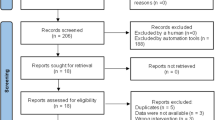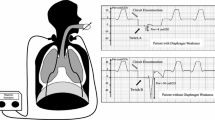Abstract
Limb muscles can be injured during and after vigourous contractions. However, this injury is most evident under specific conditions. The strength and type of muscle contraction as well as the contractile status of the muscle are important determinants of injury. The initiating event leading to muscle injury is not clearly understood but there are several leading theories. The respiratory muscles are of obvious importance to survival, and fatigue or injury to them has been hypothesized to be prevented by various mechanisms. One such mechanism is reduced activation by the central nervous system. In this review information on the neural activation of the breathing muscles during inspiratory loading is discussed and reveals that neural activation to the diaphragm, the main inspiratory muscle, is high. Previous studies investigating the presence of muscle fatigue immediately after such inspiratory loading have shown little evidence of it. However, based on information from limb muscles, delayed or secondary muscle injury might occur and could produce deleterious effects on respiratory muscle function. Recent evidence shows that chronic low intensity inspiratory loading can produce diaphragmatic injury (Reid et al.) and secondary or delayed muscle injury can occur three days after an acute period of high intensity inspiratory loading. The results reviewed in this article suggest that the respiratory muscles, specifically the diaphragm, are not spared from injury or the results of muscle injury. Diaphragmatic function during the period of secondary muscle injury is markedly impaired and thus respiratory muscle injury is a phenomenon that warrants further investigation.
Similar content being viewed by others
References
Faulkner JA, Brooks SV, Opitech JA: Injury to skeletal muscle fibres during contractions: conditions of occurrence and prevention. Phys Ther 73: 911–921, 1993
Newham DJ, McPhail KR, Mills KR, Edwards RHT: Ultrastructural changes after concentric and eccentric contractions of human muscle. J Neurol Sci 61: 109–122, 1983
Sargeant AJ, Dolan P: Human muscle function following prolonged eccentric exercise. Eur J Appl Physiol 56: 704–711, 1987
van der Meulen JH, Kuipers H, Drukker J: Relationship between exercise-induced muscle damage and enzyme release in rats. J Appl Physiol 71: 999–1004, 1991
Jones DA, Jackson MJ, Edwards RHT: Release of intracelluar enzymes from an isolated mammalian skeletal muscle preparation. Clin Sci 65: 193–201, 1983
McCully KK, Faulkner JA: Injury to skeletal muscle fibres of mice following lengthening contractions. J Appl Physiol 59: 119–126, 1985
Higuchi H, Yoshioka T, Maryama K: Positioning of actin filaments and tension generation in skinned muscle fibers released after stretch beyond overlap of the actin and myosin filaments. J Muscle Res Cell Mtil 9: 491–498, 1988
Armstrong RB: Initial events in exercise-induced muscular injury. Med Sci Sports Exercise 22: 429–435, 1990
Trump BF, Benezsky IK, Laiho KU, Osornio AR, Mergner WF, Smith MW: The role of calcium in cell injury, a review. Scanning Electron Microsc 2: 437–462, 1980
Duan C, Delp MD, Hayes DA, Delp PD, Armstrong RB: Skeletal muscle Ca2+ overload and injury from eccentric exercise. J Appl Physiol 68: 1241– 1251, 1990
Tate CA, Bonner MW, Leslie SW: Calcium uptake in skeletal muscle mitochondria. Eur J Appl Physiol 39: 111–116, 1978
Hough T: Ergographic studies in muscular soreness. Am J Physiol 7: 76–92, 1902
Byrnes WC, Clarkson PM, White JS: Delayed onset muscle soreness following repeated bouts of downhill running. J Appl Physiol 59: 710–715, 1985
Komi PV, Buskirk FR: Effect of eccentric and concentric muscle conditioning on tension and electrical activity of human muscle. Ergonomics 15: 417–434, 1972
Clarkson PM, Tremblay I: Exercise-induced muscle damage, repair, and adaptations in humans. J Appl Physiol 65: 1–6, 1988
Warren GI, Hayes DA, Lowe DA, Williams JH, Armstrong RB: Eccentric contraction-induced injury in normal and hindlimbsuspended mouse soleus and EDL muscles. J Appl Physiol 77: 1421–1430, 1994
Armstrong RB, Ogilvie RW, Schwane JA: Eccentric exercise-induced injury to rat skeletal muscle. J Appl Physiol 54: 80–93, 1983
Carlson BM, Faulkner JA: The regeneration of skeletal muscle fibres following injury: a review. Med Sci Sports Exerc 15: 187–198, 1983
Anzueto A, Andrade FH, Maxwell LC, Levine SM, Lawrence RA, Gibbons WJ, Jenkinson SG: Resistive breathing activates the gluthathione redox cycle and impairs performance of rat diaphragm. J Appl Physiol 72: 529–534, 1992
Borzone G, Zhao B, Merola AJ, Berliner L, Clanton TL: Detection of free radicals by electron spin resonance in rat diaphragm after resistive loading. J Appl Physiol 77: 812–818, 1994
Supinski G, Stofan D, Dimarco A: Effect of ischemia-reperfusion on diaphragm strength and fatigability. J Appl Physiol 75: 2180–2187, 1993
Reid WD, Huang J, Bryson S, Walker DC, Belcastro AN: Diaphragm injury and myofibrillar structure induced by resistive loading. J Appl Physiol 76: 176–184, 1994
Ferguson GT, Irvin CG, Cherniak RM: Relationship of diaphragm glycogen lactate and function to respiratory failure. Am Rev Respir Dis 141: 926–932, 1990
Merton PA: Voluntary strength and fatigue. J Physiol 123: 553–564, 1954
Stephens JA, Taylor A: Fatigue of maintained voluntary contractions in man. J Physiol (London) 220: 1–18, 1972
Bigland-Richie B: Respiratory Muscles and Their Neuromotor Control. Liss, New York, USA, 1987, pp 379–390
Aldrich TK: Transmission fatigue of the rabbit diaphragm. Res Physiol 69: 307–319, 1987
Bazzy AR, Donnelly DF: Diaphragmatic failure during loaded breathing: role of neuromuscular transmission. J Appl Physiol 74: 1679–1682, 1993
Osborne S, Road JD: Diaphragm and phrenic nerve activities during inspiratory loading in anaesthetized rabbits. Res Physiol 99: 321–330, 1995
Maycock DE, Standaert TA, Murphy TD, Woodrum DE: Diaphragmatic force and substrate response to resistive loaded breathing in the piglet. J App Physiol 70: 70–76, 1991
Road J, Osborne S, Cairns A: Phrenic motoneuron firing rates during brief inspiratory resistive loads. J Appl Physiol 79: 1540–1545, 1995
Road J, Cairns A: Phrenic motoneuron firing rates before, during and after prolonged inspiratory resistive loading. J Appl Physiol 83: 776–783, 1997
Jiang TX, Reid WD, Belcastro A, Road JD: Load dependence of secondary diaphragm inflammation and injury after acute inspiratory loading. Am J Res Crit Care Med, in press
Jiang TX, Reid WD, Road JD: Delayed diaphragm injury and diaphragm force production. Am J Res Crit Care Med, in press
Wakai Y, Leevers AM, Road JD: Regional diaphragm shortening measured by sonomicrometry. J Appl Physiol 77: 2791–2796, 1994
Author information
Authors and Affiliations
Rights and permissions
About this article
Cite this article
Road, J.D., Jiang, TX. Determinants of diaphragmatic injury. Mol Cell Biochem 179, 81–86 (1998). https://doi.org/10.1023/A:1006855819966
Issue Date:
DOI: https://doi.org/10.1023/A:1006855819966




